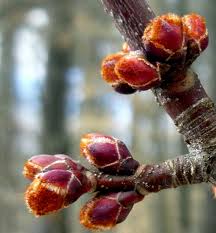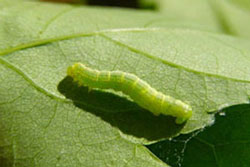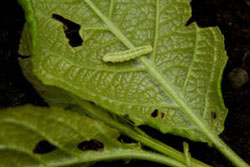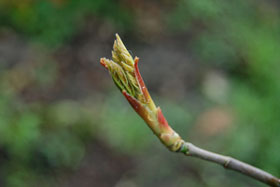Here in Southern New England, winter can be tough on us, the residents. Endless snow storms and grey, cloudy days can get to you after a while. The occasionally sunny day leaves a glimpse of hope as thoughts turn to the uplifting warmth of the spring to come. The snow melts and the trees and shrubs begin to feed again; swelling full of goodness and ready to burst into bloom. We all look forward to this hopeful time of year and to have pesky winter moth caterpillars chew away at the trees and perennials we wait all winter to enjoy, can be a bummer.
 Fig. 1
Fig. 1
During the early spring period shortly after the snow thaws, “bud swell” (fig. 1) occurs within most trees and shrubs. This is the true sign that spring and its better weather are on the way! It is also during this time that newly hatched winter moth caterpillars become active. The baby caterpillars, less than 1mm in length, spin a small silk which helps the caterpillar become airborne at such a low body weight. The caterpillar hopes to land in the extremities of a target host woody trees and perennials such as: maples, oaks, apple, crab apple, ash, blueberry and rose bushes.
Identifying The Pest
The first step in controlling any pest is proper identification. The winter moth caterpillars (fig. 2 & 3 are small, green worms, commonly referred to as “inch worms” and are typically around ½” to 1″ in length. These worms can easily be found on the extremities or underside of the hosts leaves or hanging from the host on long strands of silk.
 Fig. 2
Fig. 2
 Fig. 3
Fig. 3
Controlling the Pest
The most consistent methods in controlling the winter moth caterpillar are root drench systemic treatments and foliar treatments. We, at Simply Safer Lawn Care offer both forms of treatment.
The systemic approach works well over time to help build a preventative residual of Imidicloprid (active ingredient) in the tree that controls the target pest early in its lifecycle, at the “bud swell” stage, thus offering excellent control and protection of the host tree or shrub’s foliage. This approach is preferred as the active ingredient is very localized to the root zone and the internal structures of the target tree or shrub. A benefit of Imidicloprid is that it does not travel extensively into flowering structures, thus reducing the threat to bee’s and other non-target insects. For best results, this approach should be employed on an on-going basis to maintain the proper levels of active ingredient within the host being protected.
The foliar treatment approach offers more immediate results by treating a host tree or shrub’s leaves and bark with a mild insecticide, such as Tempo SC Ultra. This approach offers quick relief and control of the pest and has a “knock-down” effect. This foliar treatment can be used as a supplement to the systemic approach until the active ingredient has time to build up to an optimal, effective level.
Timing of Application
In order to gain effective control over the winter moth caterpillars, timing of applications is very important.
Systemic Treatments:
For systemic treatment, root drenching should occur in very early spring and/or in mid-late fall, while the target hosts are actively growing and feeding. It is important that the root drench be absorbed into the roots and begin trans locating into the extremities of the host. It does take some time for the active ingredient to reach optimal levels throughout the tree or shrub being treated, thus monitoring the host throughout the spring stage is considered proper Integrated Pest Management (IPM). Should an outbreak of the winter moth caterpillar occur, foliar treatment should be considered as a supplemental treatment until the systemic plan becomes fully effective.
Foliar Treatment:
 Fig. 4
Fig. 4
Proper timing for the foliar treatment is based around “bud swell” and more importantly “bud break” (fig. 4). In order to maximize efficiency of the treatment and to minimize the damage from winter moth caterpillar activity, initial foliar treatment should occur as quickly as possible after “bud break”. Once bud break occurs, the caterpillars begin a “free-feeding” stage and can chew through the precious foliage quickly when in high numbers. Foliar treatment offers the quickest relief during the “free-feeding” stage.
It is best to continue monitoring the treated hosts for several weeks after the initial treatment to determine if additional treatment is necessary.
